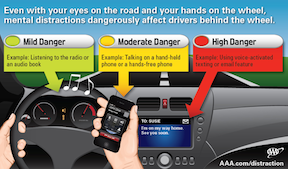 As automakers seek differentiation through innovation, speech-enabled solution providers are coming under criticism and being called upon to step up their game. The fusilade is coming from two, decidedly different fronts; each with distinct, but interrelated concerns: Safety and Product Quality.
As automakers seek differentiation through innovation, speech-enabled solution providers are coming under criticism and being called upon to step up their game. The fusilade is coming from two, decidedly different fronts; each with distinct, but interrelated concerns: Safety and Product Quality.
On the safety front, the American Automobile Association Foundation recently released a report, entitled “Measuring Cognitive Distraction in the Automobile”, with the results of a research project under the supervision of University of Utah psychology professor David Strayer designed to show levels of “cognitive distraction” resulting from variety of activities, ranging from listening to the radio or text-to-speech replays of messages to “hands-free” dictation of messages. Strayer demonstrated his resesarch methods to reporters who attended a media event at FedEx Field outside Washington, DC, and they corroborated his findings. As Isobel Markham of the Salt Lake Tribune reported, “Those hands-free speech-to-text devices were much more distracting than you might think. In fact, they’re worse than talking on a cellphone.”
On the quality front, a post by Joseph B. White in the Wall Street Journal’s “Corporate Intelligence” blog cited the results of a survey of 83,000 drivers by J.D. Power and Associates which showed that ““Voice recognition is the most frustrating, annoying, frequently reported problem,” according to Dave Sargent, president of J.D. Power’s global automotive practice. Second complaint was about failure to pair the Infotainment system with Bluetooth devices. As White notes, “None of the top five complaints involved a major mechanical failure.” Instead, new owners are finding high-tech aspects of autos to be sources of frustration.
White also notes that today’s auto buyers are not the tech-savvy 18-34 year-olds that software and service providers are trying to reach via smartphones, tablets and infotainment centers in cars. This is the last gasp of baby boomers; meaning the same folks whose nostalgia for the past has led to reboots of venerable (though largely safer) reboots of 1960’s muscle cars – Chargers, Challengers, Mustangs and Camaros. For this target market, the interior acoustics necessary for accurate speech recognition will always be secondary to the visceral feel accompanying the vibrations generated by the proverbial “three dueces and a four-speed 381” (or 5.0 Liters if you prefer).
Returning to the distracted driver and automobile safety angle, the AAA Foundation’s study is starting to get drivers and policy makers alike talking about product and service design that makes sense. Professor Strayer has already defined a gauge for cognitive distraction that can be applied to a variety of activities that take place in a car. It is clear that all of us drivers take the road at some level of impairment, whether we are talking to passengers, driving with a pet in our lap, putting on make up, drinking coffee or any of the other long-commute rituals.
As an old chestnut goes, “even bad publicity is publicity.” Both the AAA study and the J.D. Power report have raised awareness of the shortcomings of speech processing in automobiles. Auto manufacturers and speech processing “platform” providers are already addressing the known deficiencies. It’s not so much a “quality” issue as much as it is a matter of designing cars that fulfill conflicting market demands. It’s like “Star Trek” versus “Dukes of Hazzard.” While it will be a challenge, the rift reflects a positive step for both the automotive and speech communities because it reflects drivers’ high expectations for new technologies and, correspondingly, the opportunities to fulfill those expectations.
On the safety front, the question is really around the limits that regulators should put on drivers. Here in California (and many other states) there are already substantial fines attached to talking on wireless phones without using a headset or earpiece. Texting is also illegal. The proper or safe use of hands-free technologies in cars should be topics in Drivers Education (or re-education of existing drivers). It would be wrong to put a blanket prohibition on speech technologies in cars, just as it would be wrong to make it illegal to speak to passengers in the back seat of an automobile. That said, it is high time to start discussing how speech-based services (like spoken directions from human-like TTS in navigation systems or smartphone applications) that truly improve drivers’ experience.
Categories: Articles

 2025 Conversational AI Intelliview: Decision-Makers Guide to Self-Service & Enterprise Intelligent Assistants
2025 Conversational AI Intelliview: Decision-Makers Guide to Self-Service & Enterprise Intelligent Assistants  Why Is ElevenLabs Building a Conversational AI Stack?
Why Is ElevenLabs Building a Conversational AI Stack?  Talk to the Web: How NLWeb Opens Conversational Access to Site Content
Talk to the Web: How NLWeb Opens Conversational Access to Site Content  Battling ‘Botenfreude’: The Power of People and Policy
Battling ‘Botenfreude’: The Power of People and Policy